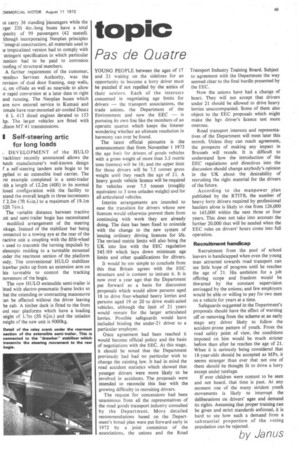topic
Page 51

If you've noticed an error in this article please click here to report it so we can fix it.
Pas de Quatre
YOUNG PEOPLE between the ages of 17 and 21 waiting on the sidelines for an opportunity to become a lorry driver must be puzzled if not repelled by the antics of their seniors. Each of the interests concerned in negotiating age limits for drivers — the transport associations, the trade unions, the Department of the Environment and now the EEC — is pursuing its own line like the members of an operatic quartet which keeps the listener wondering whether an ultimate resolution in harmony can ever be found.
The latest official pirouette is the announcement that from November 1 1973 the age limit for drivers of goods vehicles with a gross weight of more than 3.5 metric tons (tonnes) will be 18; and the upper limit for those drivers will be 7.5 tonnes gross weight until they reach the age of 21. A heavy goods vehicle licence will be required for vehicles over 7.5 tonnes (roughly equivalent to 3 tons unladen weight) and for all articulated vehicles.
Interim arrangements are intended to ease the transition for drivers whose new licences would otherwise prevent them from continuing with work they are already doing. The date has been fixed to coincide with the change to the new system of issuing ordinary driving licences for life. The revised metric limits will also bring the UK into line with the EEC regulation 543 /69 which lays down minimum age limits and other qualifications for avers. It would be too simple to conclude from this that Britain agrees with the EEC structure and is content to imitate it. It is now over a year ago that the Department put forward as a basis for discussion proposals which would allow persons aged 18 to drive four-wheeled heavy lorries and persons aged 19 or 20 to drive multi-axled vehicles, although the limit of 21 years would remain for the larger articulated lorries. Possible safeguards would have included binding the under-21 driver to a particular employer.
Once agreement had been reached it would become official policy and the basis of negotiations with the EEC. At this stage,
it should be noted that the Department previously had had no particular wish to
change the existing law. It had in mind the road accident statistics which showed that younger drivers were more likely to be involved in accidents. The proposals were intended to reconcile this fear with the growing difficulty in recruiting drivers.
The request for concessions had been unanimous from all the representatives of the road goods transport industry consulted by the Department. More detailed recommendations based on the Department's broad plan were put forward early in 1972 by a joint committee of the associations, the unions and the Road Transport Industry Training Board. Subject to agreement with the Department the way seemed clear to the final hurdle presented by the EEC.
Now the unions have had a change of heart. They will not accept that drivers under 21 should be allowed to drive heavy lorries unaccompanied. Some of them also object to the EEC proposals which might make the hgv driver's licence test more onerous.
Road transport interests and representatives of the Department will meet later this month. Unless they can reach agreement, the prospects of making any impact in Brussels will recede. It is difficult to understand how the introduction of the EEC regulations and directives into the discussion should change anybody's opinion in the UK about the desirability of recruiting the right material for the drivers of the future.
According to the manpower plan published by the RTITB, the number of heavy lorry drivers required by professional hauliers alone is likely to rise from 126,000 to 145,000 within the next three or four years. This does not take into account the further 20,000 that will be needed when the EEC rules on drivers' hours come into full operation.
Recruitment handicap Recruitment from the pool of school leavers is handicapped when even the young man attracted towards road transport can see little hope of progress until he reaches the age of 21. His ambition for a job offering scope and freedom would be thwarted by the constant supervision envisaged by the unions; and few employers would be able or willing to pay for two men on a vehicle for years at a time.
Safeguards suggested in the Department's proposals should have the effect of warning off or removing from the scheme at an early stage any driver likely to follow the accident-prone pattern of youth. From the road safety point of view, the conditions imposed on him would be much stricter before than after he reaches the age of 21.
When it is seriously being considered that 18-year-olds should be accepted as MPs, it seems stranger than ever that not one of them should be thought fit to drive a lorry except under tutelage.
If ever children were content to be seen and not heard, that time is past. At any moment one of the many strident youth movements is likely to interrupt the deliberations on drivers' ages and demand its rights. Assuming that proper training can be given and strict standards enforced, it is hard to see how such a demand from a substantial proportion of the voting population can be rejected.
by Janus




























































































